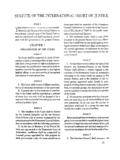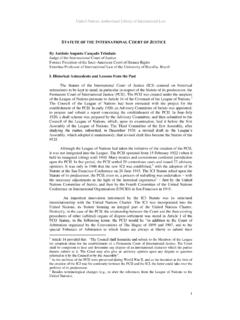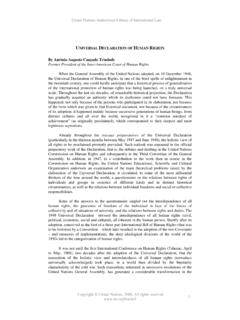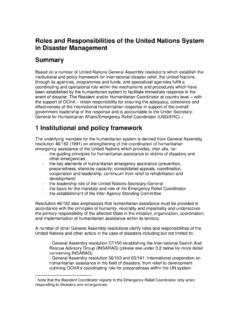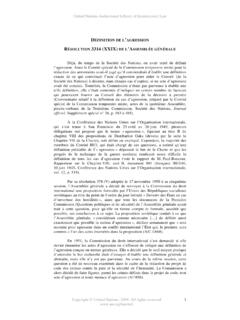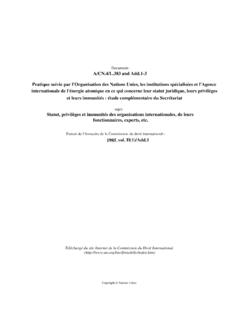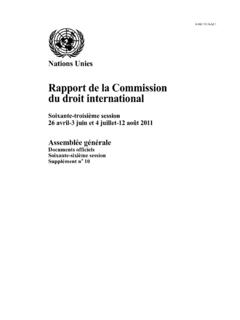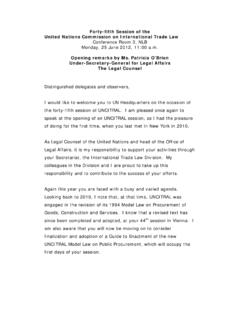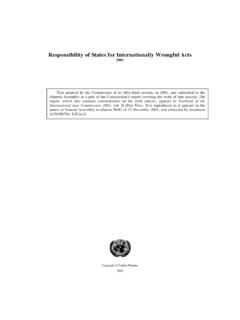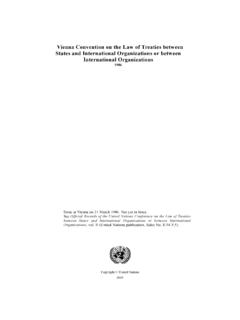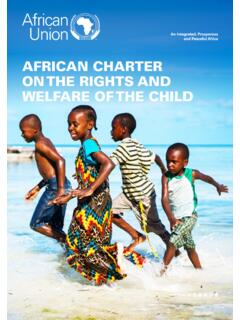Transcription of CONVENTION RELATING TO THE STATUS OF ... - United …
1 United Nations Audiovisual Library of International Law CONVENTION RELATING TO THE STATUS OF refugees PROTOCOL RELATING TO THE STATUS OF refugees By Guy S. Goodwin-Gill Senior Research Fellow, All Souls College, Oxford Introduction The 1951 CONVENTION RELATING to the STATUS of refugees , with just one amending and updating Protocol adopted in 1967 (on which, see further below), is the central feature in today s international regime of refugee protection , and some 144 States (out of a total United Nations membership of 192) have now ratified either one or both of these instruments (as of August 2008). The CONVENTION , which entered into force in 1954, is by far the most widely ratified refugee treaty, and remains central also to the protection activities of the United Nations High Commissioner for refugees (UNHCR).
2 In the aftermath of the Second World War, refugees and displaced persons were high on the international agenda. At its first session in 1946, the United Nations General Assembly recognized not only the urgency of the problem, but also the cardinal principle that no refugees or displaced persons who have finally and definitely .. expressed valid objections to returning to their countries of origin .. shall be compelled to return .. (resolution 8 (I) of 12 February 1946). The United Nations first post-war response was a specialized agency, the International Refugee Organization (IRO, 1946-1952), but notwithstanding its success in providing protection and assistance and facilitating solutions, it was expensive and also caught up in the politics of the Cold War.
3 It was therefore decided to replace it with a temporary, initially non-operational agency, and to complement the new institution with revised treaty provisions on the STATUS of refugees . The historical context also helps to explain both the nature of the CONVENTION and some of its apparent limitations. Just six years before its conclusion, the Charter of the United Nations had identified the principles of sovereignty, independence, and non-interference within the reserved domain of domestic jurisdiction as fundamental to the success of the Organization (Article 2 of the Charter of the United Nations). In December 1948, the General Assembly adopted the Universal Declaration of Human Rights, article 14, paragraph 1, of which recognizes that, Everyone has the right to seek and to enjoy in other countries asylum from persecution , but the individual was only then beginning to be seen as the beneficiary of human rights in international law.
4 These factors are important to an understanding of both the manner in which the 1951 CONVENTION is drafted (that is, initially and primarily as an agreement between States as to how they will treat refugees ), and the essentially reactive nature of the international regime of refugee protection (that is, the system is triggered by a cross-border movement, so that neither prevention, nor the protection of internally displaced persons come within its range). The United Nations High Commissioner for refugees and the 1951 CONVENTION After extensive discussions in its Third Committee, the General Assembly moved to replace the IRO with a subsidiary organ (under Article 22 of the Charter of the United Nations), and by resolution 428 (V) of 14 December 1950, it decided to set up the Office Copyright United Nations, 2008.
5 All rights reserved 1 United Nations Audiovisual Library of International Law of the United Nations High Commissioner for refugees with effect from 1 January 1951. Initially set up for three years, the High Commissioner s mandate was regularly renewed thereafter for five-year periods until 2003, when the General Assembly decided to continue the Office until the refugee problem is solved (resolution 58/153 of 22 December 2003, paragraph 9). The High Commissioner s primary responsibility, set out in paragraph 1 of the Statute annexed to resolution 428 (V), is to provide international protection to refugees and, by assisting Governments, to seek permanent solutions for the problem of refugees .
6 Its protection functions specifically include promoting the conclusion and ratification of international conventions for the protection of refugees , supervising their application and proposing amendments thereto (paragraph 8 (a) of the Statute). A year earlier, in 1949, the United Nations Economic and Social Council appointed an Ad Hoc Committee to consider the desirability of preparing a revised and consolidated CONVENTION RELATING to the international STATUS of refugees and stateless persons and, if they consider such a course desirable, draft the text of such a CONVENTION . The Ad Hoc Committee decided to focus on the refugee (stateless persons were eventually included in a second CONVENTION , the 1954 CONVENTION RELATING to the STATUS of Stateless Persons), and duly produced a draft CONVENTION .
7 Its provisional draft drew on IRO practice under its Constitution, identified a number of categories of refugees , such as the victims of the Nazi or Falangist regimes and those recognized under previous international agreements, and also adopted the general criteria of well-founded fear of persecution and lack of protection (See United Nations doc. , 23 January 1950). In August 1950, the Economic and Social Council returned the draft for further review, before consideration by the General Assembly, and then finalized the Preamble and refugee definition. In December 1950, the General Assembly decided to convene a Conference of Plenipotentiaries to finalize the CONVENTION (resolution 429 (V) of 14 December 1950).
8 The Conference met in Geneva from 2 to 25 July 1951 and took as its basis for discussion the draft which had been prepared by the Ad Hoc Committee on refugees and Stateless Persons, save that the Preamble was that adopted by the Economic and Social Council, while article 1 (definition) was as recommended by the General Assembly and annexed to resolution 429 (V). On adopting the final text, the Conference also unanimously adopted a Final Act, including five recommendations covering travel documents, family unity , non-governmental organizations, asylum, and application of the CONVENTION beyond its contractual scope. Notwithstanding the intended complementarity between the responsibilities of the UNHCR and the scope of the new CONVENTION , a marked difference already existed.
9 The mandate of the UNHCR was universal and general, unconstrained by geographical or temporal limitations, while the definition forwarded to the Conference by the General Assembly, reflecting the reluctance of States to sign a blank cheque for unknown numbers of future refugees , was restricted to those who became refugees by reason of events occurring before 1 January 1951 (and the Conference was to add a further option, allowing States to limit their obligations to refugees resulting from events occurring in Europe before the critical date). Copyright United Nations, 2008. All rights reserved 2 United Nations Audiovisual Library of International Law The CONVENTION Refugee Definition Article 1A, paragraph 1, of the 1951 CONVENTION applies the term refugee , first, to any person considered a refugee under earlier international arrangements.
10 Article 1A, paragraph 2, read now together with the 1967 Protocol and without the time limit, then offers a general definition of the refugee as including any person who is outside their country of origin and unable or unwilling to return there or to avail themselves of its protection , on account of a well-founded fear of persecution for reasons of race, religion, nationality, membership of a particular group, or political opinion. Stateless persons may also be refugees in this sense, where country of origin (citizenship) is understood as country of former habitual residence . Those who possess more than one nationality will only be considered as refugees within the CONVENTION if such other nationality or nationalities are ineffective (that is, do not provide protection ).
